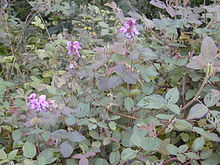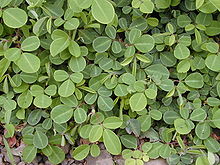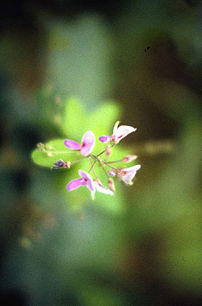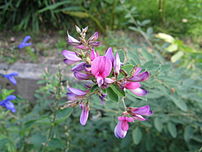- Desmodium
-
Desmodium 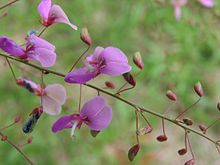
Flowers of Desmodium discolor Scientific classification Kingdom: Plantae (unranked): Angiosperms (unranked): Eudicots (unranked): Rosids Order: Fabales Family: Fabaceae Subfamily: Faboideae Tribe: Desmodieae Subtribe: Desmodiinae Genus: Desmodium
Desv.Species Many, see text
Synonyms Catenaria Benth.
Desmofischera Holthuis
Dollinera Endl.
Hanslia Schindl.
Hegnera Schindl.
Holtzea Schindl.
Hylodesmum H. Ohashi & R. R. Mill
Meibomia Heist. ex Fabr.
Monarthrocarpus Merr.
Murtonia Craib
Nephromeria (Benth.) Schindl.
Nicolsonia DC.
Ohwia H. Ohashi
Ougeinia Benth.
Papilionopsis Steenis
Podocarpium (Benth.) Y. C. Yang & P. H. HuangDesmodium is a genus in the flowering plant family Fabaceae, sometimes called tick-trefoil, tick clover or beggar lice. There are dozens of species and the delimitation of the genus has shifted much over time.
These are mostly inconspicuous legumes; few have bright or large flowers. Though some can become sizeable plants, most are herbs or small shrubs. Their fruit are loments, meaning each seed is dispersed individually enclosed in its segment. This makes them tenacious plants and some species are considered weeds in places. They do have a variety of uses though, which are not readily apparent from their modest looks.
Contents
Uses
Several Desmodium species contain potent secondary metabolites. They are used aggressively in agriculture as part of the push-pull technology. Tick-trefoils produce extremely high amounts of antixenotic allomones - chemicals which repel many insect pests - and allelopathic compounds which kill weeds. For example, D. intortum and D. uncinatum are employed as groundcover in maize and sorghum fields to repel Chilo partellus stem-borer grass moths. They also suppress witchweeds such as Asiatic Witchweed (Striga asiatica) and Purple Witchweed (S. hermonthica).
Tick-trefoils are generally useful as living mulch and as green manure, as they are able to replenish soil fertility due to their nitrogen fixation. Most also give good animal fodder.
Some Desmodium species were shown to contain elevated amounts of tryptamine alkaloids. This is widespread in this genus and its relatives, and many tryptamine-containing plants treated in Desmodium are not placed herein anymore (see also below).
DMT and 5-MeO-DMT have been shown to occur in all green parts of D. gangeticum, as well as the roots. D. triflorum roots contain DMT-N-oxide.[citation needed]
There do not appear to be many animals that regularly feed on Desmodium, but detailed research in these interesting plants is lacking. Lesser Grass Blue (Zizina otis) caterpillars are known to feed in tick-trefoil, as well as, occasionally, those of the Two-barred Flasher (Astraptes fulgerator).
Taxonomy and systematics
The taxonomy and systematics of the many dozens of Desmodium species are extremely confusing and far from resolved. Related genera such as Codariocalyx, Hylodesmum, Lespedeza, Ohwia and Phyllodium were and sometimes still are included in Desmodium.[1]
Many of these plants being rather small, inconspicuous and nondescript, the same taxa have been applied to what later turned out to be very different species. For example, D. spirale as described by August Grisebach might refer to a distinct species but its validity is doubtful; the "D. spirale" of other authorities may refer to either of D. neomexicanum, D. ospriostreblum or D. procumbens. Similarly, the plant originally described as D. podocarpum by A. P. de Candolle is Hylodesmum podocarpum today, but "D. podocarpum" might also mean D. hookerianum or Hylodesmum laxum, depending on the taxonomic authority.[1]
Selected species[1]
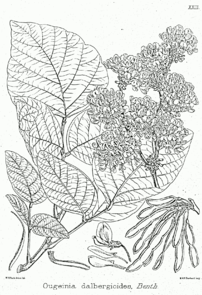 Desmodium oojeinense parts drawing. Dietrich Brandis (1874): Illustrations of the Forest Flora of North-West and Central India.
Desmodium oojeinense parts drawing. Dietrich Brandis (1874): Illustrations of the Forest Flora of North-West and Central India.
- Desmodium acanthocladum F.Muell.
- Desmodium adscendens DC.
- Desmodium canadense – Showy Tick-trefoil, Canadian Tick-trefoil
- Desmodium canescens – Hoary Tick-trefoil
- Desmodium ciliare (Muhl.) DC. – Hairy Small-leaved Tick-trefoil
- Desmodium concinnum DC.
- Desmodium concinnum var. concinnum (= D. penduliflorum Benth.)
- Desmodium cuspidatum (Muhl.) Loudon – Toothed Tick-trefoil, Large-bracted Tick-trefoil
- Desmodium dillenii Darl. (sometimes considered a variety of D. paniculatum)
- Desmodium discolor Vog.
- Desmodium elegans DC.
- Desmodium gangeticum
- Desmodium glabrum (Mill.) DC. (= D. molle (Vahl) DC.)
- Desmodium glutinosum (Willd.) Alph. Wood – Pointed-leaved Tick-trefoil, Large Tick-trefoil
- Desmodium hookerianum D. Dietr. (= D. podocarpum Hook. & Arn.)
- Desmodium illinoense – Illinois Tick-trefoil
- Desmodium incanum – Creeping Beggarweed, Spanish Clover, Spanish Tick-trefoil, Kaimi Clover or kaʻimi (Hawaiʻi)
- Desmodium intortum
- Desmodium khasianum (= D. oxyphyllum auct. non DC.)
- Desmodium laxiflorum DC. (= D. incanum sensu auct.[2])
- Desmodium lineatum (Michx.) DC. – Linear-leaved Tick-trefoil
- Desmodium marilandicum (L.) DC. – Smooth Small-leaved Tick-trefoil
- Desmodium nemorosum F.Muell. ex Benth.
- Desmodium neomexicanum (= D. bigelovii, D. humile, D. lilloanum, D. parvum, D. spirale auct. non DC. non Griseb. non (Sw.) DC., D. spirale (Sw.) DC. var. bigelovii)
- Desmodium nudiflorum (L.) DC. – Bare-stemmed Tick-trefoil, Naked-flowered Tick-trefoil
- Desmodium oojeinense
- Desmodium ospriostreblum (= D. spirale DC., D. tortuosum sensu Hepper)
- Desmodium paniculatum (L.) DC. – Panicled Tick-trefoil
- Desmodium perplexum – Perplexed Tick-trefoil
- Desmodium procumbens (= D. spirale (Sw.) DC., D. sylvaticum, D. tenuiculum)
- Desmodium psilocarpum
- Desmodium rhytidophyllum F.Muell. ex Benth.
- Desmodium rigidum (Ell.) DC. – Rigid Tick-trefoil
- Desmodium rotundifolium (Michx.) DC. – Prostrate Tick-trefoil, Round-leaved Tick-trefoil, Dollar Leaf
- Desmodium spirale Griseb. (disputed)
- Desmodium tortuosum (Sw.) DC.
- Desmodium triflorum
- Desmodium uncinatum – Silver-leaved Tick-trefoil, "silverleaf"
- Desmodium varians (Labill.) G.Don
Formerly placed here[1]
- Codariocalyx motorius – Telegraph Plant (as D. gyrans, D. motorium, D. roylei)
- Hylodesmum laxum (as D. laxum DC.)
- Hylodesmum laxum ssp. laxum (as D. austro-japonense, D. bambusetorum, D. gardneri auct. non Benth., D. laxiflorum sensu Miq., D. laxum var. kiusianum, D. laxum ssp. laxum, D. podocarpum auct. non DC. non Hook. & Arn., D. podocarpum DC. var. gardneri sensu Bedd., D. podocarpum DC. var. laxum)
- Hylodesmum leptopus (as D. gardneri Benth., D. laxum auct. non DC., D. laxum ssp. leptopus, D. leptopus, D. tashiroi)
- Hylodesmum podocarpum (as D. podocarpum DC., D. podocarpum DC. var. indicum, D. podocarpum DC. var. japonicum)
- Hylodesmum podocarpum ssp. oxyphyllum (as D. fallax var. mandshuricum, D. japonicum, D. mandshuricum, D. oxyphyllum DC., D. podocarpum DC. var. mandshuricum, D. podocarpum DC. ssp./var. oxyphyllum, D. podocarpum DC. var. polyphyllum, D. podocarpum DC. var. typicum, D. racemosum)
- Lespedeza thunbergii (as D. formosum, D. thunbergii)
- Lespedeza thunbergii var. thunbergii (as D. penduliflorum Oudem.)
- Ohwia caudata (as D. caudatum)
- Phyllodium pulchellum (as D. pulchellum)
and many more
See also
Footnotes
References
- International Legume Database & Information Service (ILDIS) (2005): Genus Desmodium. Version 10.01, November 2005. Retrieved 2007-DEC-17.
External links
- Trout’s Notes on the Genus Desmodium Chemistry, ethnomedicine, pharmacology, synonyms and miscellany (pdf)
Categories:- Desmodium
- Medicinal plants
- Forages
Wikimedia Foundation. 2010.

